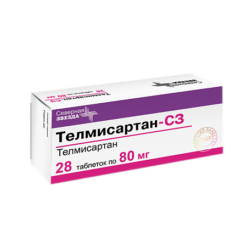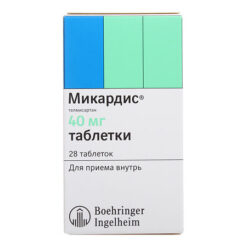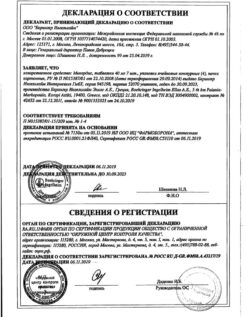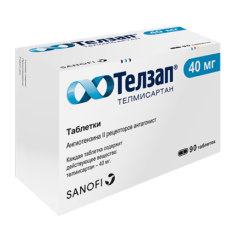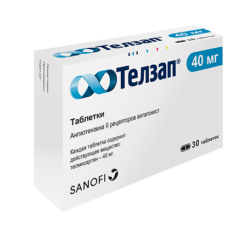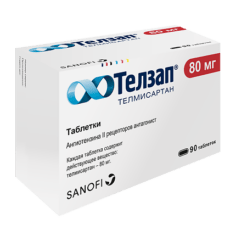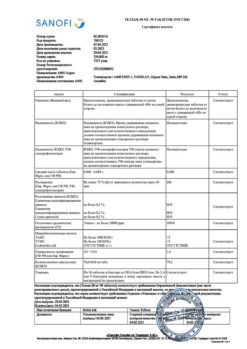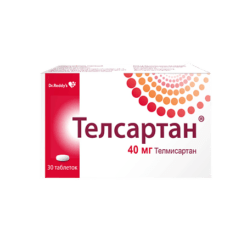No products in the cart.
Telmisartan-SZ, 40 mg tablets 30 pcs
€9.34 €8.17
Description
Pharmacodynamics
Telmisartan is a specific angiotensin II receptor antagonist (type AT,) effective when taken orally. It has a high affinity for the subtype AT, angiotensin II receptors, through which the action of angiotensin II is realized. It displaces angiotensin II from binding to the receptor, having no agonist effect against this receptor.
Telmisartan binds only to the AT subtype, angiotensin II receptor. The binding is long-lasting. It has no affinity for other receptors, including AT2 receptor and other, less studied angiotensin receptors. The functional significance of these receptors and the effect of their possible overstimulation by angiotensin II, the concentration of which increases with telmisartan administration, has not been studied. It reduces the blood concentration of aldosterone, does not inhibit plasma renin and does not block ion channels. Telmisartan does not inhibit angiotensin-converting enzyme (kininase II) (an enzyme that also degrades bradykinin). Therefore, an increase in bradykinin-induced side effects is not expected.
In patients, telmisartan at a dose of 80 mg completely blocks the hypertensive effects of angiotensin II. The onset of antihypertensive action is noted within 3 hours after the first dose of telmisartan. The action of the drug persists for 24 hours and remains significant up to 48 hours. A pronounced antihypertensive effect usually develops in 4-8 weeks after regular oral administration.
In patients with arterial hypertension, telmisartan reduces systolic and diastolic blood pressure (BP) without affecting heart rate (HR).
In case of abrupt telmisartan withdrawal, BP gradually returns to baseline levels without development of “withdrawal” syndrome.
Pharmacokinetics
In oral administration, it is rapidly absorbed from the gastrointestinal tract. Bioavailability is 50%. When taken concomitantly with food, the AUC (area under the curve “concentration-time”) decrease ranges from 6% (at a dose of 40 mg) to 19% (at a dose of 160 mg). Three hours after ingestion, plasma concentrations level off, regardless of the time of ingestion. There is a difference in plasma concentrations between men and women. Stath (maximum concentration) and AUC were approximately 3 and 2 times higher in women compared to men, respectively, with no significant effect on efficacy.
The binding to plasma proteins is 99.5%, mainly to albumin and alpha-1 glycoprotein. Average apparent volume of distribution at equilibrium concentration-500 l. Metabolized by conjugation with glucuronic acid. Metabolites are pharmacologically inactive. The elimination half-life is more than 20 hours. Excreted intestinally unchanged, renal excretion is less than 2% of the dose taken Total plasma clearance is high (900 ml/min) compared to “hepatic” blood flow (about 1500 ml/min)
Elderly patients
The pharmacokinetics of telmisartan in elderly patients does not differ from younger patients. No dose adjustment is required.
Patients with renal impairment
Dose adjustments are not required in patients with renal impairment, including patients on hemodialysis Telmisartan is not removed by hemodialysis.
Patients with hepatic impairment
In patients with mild to moderate hepatic impairment (Child-Pugh grades A and B), the daily dose of the drug should not exceed 40 mg
Pediatric use
Pediatric use The basic pharmacokinetics of telmisartan in children aged 6 to 18 years, after administration of telmisartan at a dose of 1 mg/kg or 2 mg/kg for 4 weeks, are generally comparable to those obtained with adult treatment and confirm the non-linearity of telmisartan pharmacokinetics, especially with respect to C_
Indications
Indications
– Arterial hypertension.
– Reduced cardiovascular morbidity and mortality in patients aged 55 years and older with a high risk of cardiovascular disease.
Active ingredient
Active ingredient
Composition
Composition
1 tablet contains:
active ingredient: telmisartan – 40 mg
excipients: sodium hydroxide – 3.4 mg; povidone K 30 (polyvinylpyrrolidone medium molecular weight) -12.0 mg; meglumine -12.0 mg; mannitol -165.2 mg; magnesium stearate – 2.4 mg; talc – 5.0 mg.
How to take, the dosage
How to take, the dosage
Overly, regardless of the time of meals.
Hypertension
The initial recommended dose of Telmisartan-SZ is 1 tablet (40 mg) once daily. In cases when therapeutic effect is not achieved, the maximum recommended dose of Telmisartan-SZ can be increased to 80 mg once daily. When deciding whether to increase the dose, it should be taken into account that the maximum antihypertensive effect is usually achieved within 4 to 8 weeks after the start of treatment.
Lower cardiovascular morbidity and mortality The recommended dose is 1 tablet of Telmisartan-SZ 80 mg, once daily. In the initial period of treatment, additional BP adjustment may be required.
In patients with renal impairment, including patients on hemodialysis, dosing adjustments are not necessary. In patients with severe renal impairment and patients on hemodialysis who have limited experience with the drug, it is recommended to start therapy with an initial dose of 20 mg (1/2 tablet of 40 mg). Liver dysfunction
In patients with mild to moderate hepatic impairment (Child-Pugh grades A and B, respectively) the daily dose of Telmisartan-SZ should not exceed 40 mg Elderly patients
The dosing regimen does not require changes.
Interaction
Interaction
Telmisartan may increase the antihypertensive effect of other hypotensive agents. Other types of interactions of clinical significance have not been identified.
Concomitant use with digoxin, warfarin, hydrochlorothiazide, glibenclamide, ibuprofen, paracetamol, simvastatin and amlodipine does not lead to clinically significant interactions. There was an increase in the average plasma concentration of digoxin by an average of 20% (in one case by 39%). When concomitant use of telmisartan and digoxin, periodic determination of digoxin blood concentrations is advisable.
In concomitant use of telmisartan and ramipril, a 2.5-fold increase in AUC0 24 and St1)! of ramipril and ramiprilat was observed. The clinical significance of this phenomenon has not been established.
Concomitant use of angiotensin-converting enzyme inhibitors (ACE) and lithium preparations has resulted in a reversible increase in lithium blood concentrations accompanied by toxic effects. In rare cases, similar changes have been reported when prescribing angiotensin II receptor antagonists. When concomitant use of lithium and angiotensin II receptor antagonists it is recommended to determine the blood concentration of lithium.
The treatment with nonsteroidal anti-inflammatory drugs (NSAIDs), including acetylsalicylic acid as an anti-inflammatory agent (more than 3 g/day), cyclooxygenase-2 inhibitors (COX-2) and non-selective NSAIDs, may cause acute renal failure in dehydrated patients. Drugs acting on the renin-angiotensin-aldosterone system (RAAS) may have a synergistic effect. In patients receiving NSAIDs and telmisartan, blood pressure should be compensated and renal function should be monitored at the beginning of treatment.
A decreased effect of hypotensive agents such as telmisartan through inhibition of the vasodilatory effect of prostaglandins has been noted with concomitant treatment with NSAIDs. Concomitant use with aliskiren is contraindicated in patients with diabetes mellitus or moderate to severe renal insufficiency (FFR < 60 ml/min/1.73 ml/min/m2 body surface area).
The use of ACE inhibitors and ARA II in patients with diabetic nephropathy is contraindicated.
. Concomitant use with ACE inhibitors, potassium-saving diuretics (spironolactone, eplerenone, triamterene or amiloride), immunosuppressors (cyclosporine or tacrolimus), trimethoprim and other drugs that can increase serum potassium levels, and potassium-containing supplements, especially in patients with renal failure, increases the risk of hyperkalemia. Regular monitoring of serum potassium is necessary. Concomitant use is not recommended.
Special Instructions
Special Instructions
In some patients, renal function (including acute renal failure) is impaired due to suppression of the RAAS, especially when using a combination of agents acting on this system. Therefore, therapy accompanied by such dual RAAS blockade (e.g., when adding iAPP or direct renin inhibitor aliskiren to APA II) should be performed on a strictly individual basis and with close monitoring of renal function (including periodic monitoring of serum potassium and creatinine).
. In cases of dependence of vascular tone and renal function predominantly on RAAS activity (e.g., in patients with chronic heart failure, or renal diseases, including bilateral renal artery stenosis or arterial stenosis of the sole kidney), the administration of drugs affecting this system may be accompanied by the development of acute arterial hypotension, hyperazotemia, oliguria, and, in rare cases, acute renal failure.
Based on experience with other agents affecting the RAAS, when co-administration of Telmisartan-SZ and potassium-saving diuretics, potassium supplements, potassium-containing dietary salt, other agents that increase blood potassium content (e.g., heparin), this parameter should be controlled in patients.
In patients with diabetes mellitus and additional cardiovascular risk, such as patients with diabetes and coronary heart disease (CHD), the risk of fatal myocardial infarction and sudden cardiovascular death may increase if blood pressure-lowering drugs such as angiotensin II receptor antagonists (ARA II) or ACE inhibitors are used. In patients with diabetes mellitus, CHD may be asymptomatic and therefore may be undiagnosed. In patients with diabetes mellitus, appropriate diagnostic tests, including exercise testing, should be performed before initiating the use of Telmisartan-SZ for the detection and treatment of CHD.
Synopsis
Synopsis
Contraindications
Contraindications
– Hypersensitivity to the active ingredient or excipients of the drug
– Pregnancy
– Breast-feeding period.
– Obstructive biliary tract disease
– Severe hepatic impairment (Child-Pugh class C)
The concomitant use of the drug – Concomitant use of Telmisartan-SZ with aliskiren in patients with diabetes mellitus or renal impairment (glomerular filtration rate (GFR) < 60 ml/min/1.73 ml/min/m2 body surface area)
– Under 18 years of age (efficacy and safety not established)
WARNING
– Bilateral renal artery stenosis or artery stenosis of the single kidney
– Liver and/or renal function abnormalities (see “Cautionary Notes.
– Reduced circulating blood volume (CBC) due to previous diuretic therapy, restriction of table salt intake, diarrhea or vomiting
– Hypotensive artery disease (see “Special Precautions”).
– Hyponatremia
– Hyperkalemia
– Post renal transplant conditions (no experience of use)
– Chronic heart failure
– Aortic and mitral valve stenosis
– Hypertrophic obstructive cardiomyopathy
– Primary aldosteronism (efficacy and safety not established)
/p>
– Hemodialysis
Pregnancy and Breastfeeding use
The use of Telmisartan-SZ is contraindicated during pregnancy. The use of angiotensin II receptor antagonists during the first trimester of pregnancy is not recommended, these drugs should not be prescribed during pregnancy. If pregnancy is diagnosed, the drug should be discontinued immediately. If necessary, alternative therapy (other classes of hypotensive drugs approved for use during pregnancy) should be prescribed.
The use of angiotensin II receptor antagonists during the second and third trimesters of pregnancy is contraindicated.
In preclinical studies of telmisartan no teratogenic effects were found, but fetotoxicity was established. It is known that exposure to angiotensin II receptor antagonists during the second and third trimesters of pregnancy causes fetotoxicity in humans (decreased renal function, oligohydroamnion, delayed cranial ossification) and neonatal toxicity (renal failure, arterial hypotension, hyperkalemia). Alternative therapy should be administered to patients planning pregnancy. If treatment with angiotensin II receptor antagonists occurred during the second trimester of pregnancy, evaluation by ultrasound of renal function and fetal cranial status is recommended.
Newborns whose mothers received angiotensin II receptor antagonists should be closely monitored for arterial hypotension.
Telmisartan-SZ therapy is contraindicated during breastfeeding
Fertility effects studies have not been performed.
Side effects
Side effects
The observed incidences of side effects did not correlate with the gender, age, or race of patients.
The World Health Organization (WHO) classification of the incidence of side effects is: very often >1/10
often from >1/100 to < 1/10
infrequently from >1/1000 to < 1/100
rarely from >1/10000 to < 1/1000
very rare < 1/10000
frequency unknown cannot be estimated from available data.
Infections:
Rare: thrombocytopenia;
frequency unknown: eosinophilia.
Anxiety of the central nervous system:
Infrequent: insomnia, somnolence, depression, vertigo;
Rarely: fainting, anxiety.
An organ of vision:
Rarely: visual disturbances.
Cardiovascular system disorders:
Infrequent: bradycardia, marked decrease in BP, orthostatic hypotension;
Rarely: tachycardia.
Respiratory system disorders:
Infrequent: shortness of breath, cough.
Digestive system disorders:
Infrequent: abdominal pain, diarrhea, dyspepsia, flatulence,vomiting;
Rarely: dry mouth, stomach discomfort, liver disorders/liver disease’ (*By postmarketing observation, most cases of liver disorders/liver disease were found in Japanese patients.)
Allergic reactions:
Infrequent: skin itching, rash, hyperhidrosis;
Rarely: Hypersensitivity (erythema, angioedema), eczema, angioedema (fatal), drug rash, toxic rash;
Frequent unknown: anaphylactic reactions, urticaria.
Musculoskeletal disorders:
Infrequent: myalgia, back pain, muscle spasms (cramps of the calf muscles); Rarely: Arthralgia, pain in the lower extremities;
Frequent unknown: tendon pain (symptoms similar to the manifestation of tendonitis).
Renal and urinary tract disorders:
Infrequent: impaired renal function, including acute renal failure.
General:
Infrequent: chest pain, general weakness;
Rarely: flu-like syndrome.
Laboratory findings:
Infrequent: hyperkalemia, increased blood creatinine concentration; Rarely: Increased blood uric acid concentration, increased “hepatic” enzyme activity, increased creatine phosphokinase (CPK) activity, decreased hemoglobin, hypoglycemia (in patients with diabetes);
In the post-marketing period of telmisatran, noted:
Very rare: interstitial lung disease (causal relationship not established).
Overdose
Overdose
No cases of overdose have been identified.
Symptoms: marked BP decrease, tachycardia, bradycardia.
Treatment: symptomatic therapy, hemodialysis is ineffective.
Similarities
Similarities
Additional information
| Shelf life | 3 years. Do not use after the expiration date printed on the package. |
|---|---|
| Conditions of storage | In the dark place at a temperature not exceeding 25 °С. Contain out of reach of children. |
| Manufacturer | North Star NAO, Russia |
| Medication form | pills |
| Brand | North Star NAO |
Other forms…
Related products
Buy Telmisartan-SZ, 40 mg tablets 30 pcs with delivery to USA, UK, Europe and over 120 other countries.


